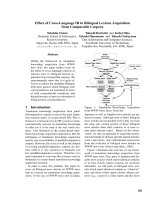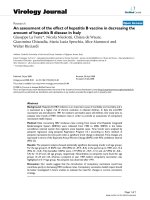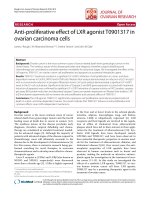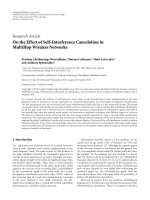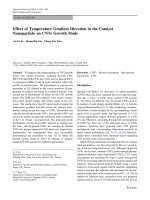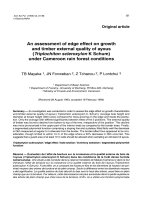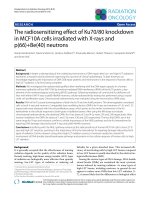Effect of shading levels before harvesting on productivity and green tea quality of Kim Tuyen variety in summer
Bạn đang xem bản rút gọn của tài liệu. Xem và tải ngay bản đầy đủ của tài liệu tại đây (141.21 KB, 6 trang )
Journal of Vietnam Agricultural Science and Technology - No.1(3)/2018
EFFECT OF SHADING LEVELS BEFORE HARVESTING ON PRODUCTIVITY
AND GREEN TEA QUALITY OF KIM TUYEN VARIETY IN SUMMER
Nguyen Xuan Cuong*1, Nguyen Ngoc Binh1, Nguyen
i
anh Hai1
Abstract
Green tea production in Vietnam is now becoming cradles for the country tea industry. Yield and quality are always
the pillars for this commodity. In this research, the impacts of di erent shading levels, under shading on yield
potential and fresh material quality were evaluated. e study was conducted for Kim Tuyen variety in summer
season in Phu o province. Four tested shading levels were 90%, 70%, 50% and full sun (the control), applied 14
days prior to harvest. e study con rmed that the Kim Tuyen variety yielded signi cantly higher than the control
in the treatments of 70% and 50% provided shade, reached 8.61 tons/ha and 8.38 tons/ha, respectively. However,
by providing 90% shade, tea yield was reduced signi cantly. In terms of drinking quality of the outcome green tea
product, the treatments of 70% and 90% shade stood at the top two of organoleptic tasting quality, whereas the
treatment of 50% shade was not signi cantly di erent in comparison to the control. e organoleptic tasting score of
these top treatments reached 17.3 - 17.4 points. Especially, they demonstrated a remarkable high score in aroma and
taste. Finally, with the exception of tea mosquito bugs, the detected number of other main pests found to be reduced
when higher levels of shade provided, including lea opper, red mites, and thrips. Consequently, this treatment
provided the highest net bene t for green tea production, reached VND 118.5 million/ha.
Keywords: Green tea quality, Kim Tuyen variety, shading level
INTRODUCTION
Green tea quality depending on chemical components
of raw tea materials and the processing technology.
Chemical elements components of tea shoots are
always uctuant and depend on many factors such
as varieties, tea age, fertilizers, technical cultivation,
soil and climatic conditions, in which including light
intensity and standard of harvested raw material.
Some studies have shown that shading for summer
tea plants increased the content of amino acid,
especially the compounds of theanine in tea shoots
while reducing the tannin content (Nguyen Dang
Dung and Le Nhu Bich, 2006; Zhao - Tiantian, 2010;
Liu Xingru, 2011; Deng and Wei-Wei, 2013; Lee and
Lan-Sook, 2013; Song, R., 2012).
e raw material from Kim Tuyen variety has
processed green tea products with high quality
especially in winter - spring season. In order to
improve the potential of this variety we implemented
the research on “E ect of shading levels before
harvesting on productivity and green tea quality of
Kim Tuyen variety in summer”.
MATERIALS AND METHODS
Materials
- Kim Tuyen tea variety has been recognized as a new
national variety by Dicision No.110/QD-TT-CCN
of Ministry of Agriculture and Rural Development,
dated 3rd June, 2008.
1
*
- Shading net: Cover sheet by PE, black, dimension of
2 m ˟ 50 m; Using two types of black shading net, the
thickness reduced by 70% light intensity, the thin one
reduced by 50% light intensity, combining both kinds
of layers reduced by 90% light intensity.
- Shading frame: Shaped boxes, piles and transverse
ute made from bamboo, each recipe distance 4.5 m ˟
10 m, height of 1.5 meters above the canopy.
- Light intensity meter: Extech Light Meter Model
401025 - ITALIA.
- Cultivation process followed by popular cultivation
technique.
+ Tea density: 22,000 trees/ha; tea planted in 2008
(10 years old).
+ Shading time in the year: from May to August.
Methods
Experimental treatments
- T1 (CT1): Full sun (control); T2 (CT2): reducing
50% light intensity, 14 days before harvesting; T3
(CT3): reducing 70% light intensity, 14 days before
harvesting; and T4 (CT4): reducing 90% light
intensity, 14 days before harvesting.
e experiment was designed in randomized
complete block (RCBD), three replications. e plot
area was 45 m2; Total area of 600 m2.
- Technical application: e height of the shading
frame was 1.5 m above the tea canopy surface.
Northern Moutainous Agriculture and Forestry Science Institute
Corresponding author: Nguyen Xuan Cuong. Email:
53
Vietnam Academy of Agricultural Sciences (VAAS)
- Experimental background: Cutting, picking,
fertilizing, irrigating, caring folloed by popular
cultivation technique.
- 5 tea plants were randomly selected for each treatment
with 3 replicates, the total number of trees was 15.
Data analysis
e experimental data were processed according to
IRRISTAT 5.0 and Excel 2010 so ware.
Time and place of the study
- Research time: From 2015 to 2017 (3 years).
Monitoring indicators
- Density of buds (buds per m2): e number of buds
quali ed in the frame 25 ˟ 25 cm (5 points diagonal).
- Length of buds of 1 tip and three leaf (centimeters):
Samples were diagonally collected at 5 points for
each plot. 50 buds were measured for each point and
calculated the average value.
- Weight of buds of 1 tip and three leaf (gram per
bud): Samples were diagonally collected at 5 points
for each plot. 100 g of buds was collected for each
point and calculated the average value.
- Productivity of fresh tea buds per ha: Weigh the
volume of fresh tea bud per umbrella and then
calculated in ha.
- Composition of buds (%): ratio of fresh tea
buds according to TCVN 1053-86; Biochemical
components (tannins, soluble substances, amino
acids, chlorophyll and aromatics) and Biochemical
components followed by TCVN 3218-2012.
- Research site: Northern Mountainous Agriculture
and Forestry Science Institute, Phu Ho commune,
Phu o town, Phu o province.
RESULTS AND DISCUSSION
E ect of shading levels before harvesting on
growth and productivity indicators of Kim Tuyen
tea variety in summer
According to table 1, the di erent levels of light
intensity before harvesting a ected the growth and
productivity of Kim Tuyen tea. Buds density ranged
from 182.15 to 226.41 buds/m2. e CT2 and CT3
buds density were signi cantly higher than control
(P < 0.05). CT3 had the highest buds density (226.41
buds per square meters). CT4 buds density (182.15
buds per square meters) was signi cantly lower than
that of the control treatment (P < 0.05).
Table 1. E ect of shading levels before harvesting some growth
and productivity indicators of Kim Tuyen tea variety
Buds density (buds
per square meters)
Weight of bud
(gr per bud)
Length of buds of 1 tip
and three leaf (cm)
Yield
(tons per ha)
CT1 (control)
210.50
0.96
6.42
8.15
CT2
215.23
0.97
7.34
8.38
CT3
226.41
0.98
7.85
8.61
CT4
182.15
0.94
6.21
7.85
LSD0. 05
4.03
0.14
0.22
0.23
CV (%)
1.0
7.2
1.6
1.4
Treatment
e weight of bud: e bud weight ranged from 0.93 to
0.98 grams per bud at di erent shading levels and there
was no di erence among treatments. CT3 had the
highest bud weight of 0.98 g/bud, the lowest was CT4
0.93 g/bud. It could be seen that the di erent levels of
light intensity do not a ect the tea shoot weight.
Table 1 also shows that the CT2 and CT3 bud length
were signi cantly di erent from control treatment (P
< 0.05). CT3 had the highest bud length (7.85 cm).
CT4 had a bud length of 6.21cm with no di erence
54
from the control (6.42 cm).
Yield of fresh tea buds: CT3 with reducing light
intensity by 70% in 14 days before harvesting achieved
the highest yield (8.61 tons per ha), signi cant
di erence compared with the control. CT2 with a
decrease of light intensity by 50% in 14 days before
harvesting was not signi cantly di erent compared to
control formula. CT4 with a decrease of light intensity
by 90% in 14 days before harvesting yielded (7.85 ton
per ha) was lower than that of control (P < 0.05).
Journal of Vietnam Agricultural Science and Technology - No.1(3)/2018
In uence of shading levels pre-harvesting on the
material composition and quality of Kim Tuyen tea
variety in summer season
e quality of fresh bud material is strongly
predominant the tea product value. In which, fresh
material classi cation is one of the most important
indicators for assessing material quality. Table 2
below demonstrates how di erent reducing light
levels a ected on the fresh bud material.
Table 2. E ects of shading levels pre-harvesting on physical composition
and quality of fresh bud material of Kim Tuyen variety
Treatment
CT1 (control)
CT2
CT3
CT4
Semi-matured
rate (%)
16.42
16.26
15.84
14.45
Rate of bud
banji (%)
6.31
6.28
6.65
7.34
Tip
7.62
7.86
8.20
7.75
Bud composition: Di erent levels of shading e ected on
tested bud composition. e highest proportion of tip
and 1st leaf and second leaf in CT3 while its proportion
of 3rd leaf and stem was lowest, which indicated that
CT3 was the most potential for high-quality material.
e proportion of tip and 1st and 2nd leaves was
lowest in CT1 (the control) while its proportion of 3rd
leaf and stem was largest, demonstrated less bene cial
characteristics for the material quality.
Material classi cation: CT4 demonstrated to be the
lowest quality as it had a low rate of semi-matured
and high rate of bud banji. In this treatment, the
Bud physical composition (%)
1st leaf
2nd leaf
3rd leaf
9.6
20.35
29.78
9.72
21.42
29.43
9.8
21.45
29.17
9.65
20.96
29.46
Stem
32.65
31.57
31.38
32.18
rate of semi-matured part was only 14.45%. It was
followed by CT3 and CT2 (15.84% and 16.26%
respectively). CT4 also showed to be highest in bud
banji rate (7.34%).
In uence of shading levels pre-harvesting on
biochemical content of tea bud in the summer
season
Table 3 reports the analyzed biochemical content
results under di erent reducing light intensity prior
to harvest of Kim Tuyen variety.
Table 3. Bio-chemical content of tea bud in summer season, by di erent pre-harvesting shading levels
Treatment
CT1 (control)
CT2
CT3
CT4
Tanin (%)
Dissolved
matter
(%)
Amino
acid (%)
Rate of
Tannin and
amino acid
28.42
27.82
26.22
24.79
42.46
42.59
42.37
42.21
2.27
2.35
2.46
2.53
12.5
11.8
10.7
9.8
e analyzed data con rmed that the changed level
of light in uenced the biochemical content in the
tea bud. Tannin content varied from 24.79 to 28.42%
and appeared to decline when the light levels were
reduced. e research showed that the tannin content
was highest at treatment CT1 (28.42%) and lowest at
treatment CT4 (24.79%). As a result, reducing light
intensity would decrease tannin content which is
more favorable for high-quality green tea processing.
Dissolved matter content in tea bud ranged from
42.21 to 42.46%, which was highest in CT1 and
lowest in CT4. us, reducing light level would lower
dissolved matter content in tea buds, which may a ect
negatively on the outcome products.
Chlorophyll (mg per
gram of fresh matter)
Ca
Cb
19.24
14.89
21.34
16.28
23.67
19.28
25.88
21.65
Fragrance
Index (*)
44.20
44.64
44.64
46.64
Amino acid is an important element deciding the
quality of green tea, the higher content of Amino acid,
the higher quality. In the study, CT4 demonstrated to
generate the highest content of Amino acid (2.53%)
while the control was only 2.27%. CT2 and CT3
contributed greater to Amino acid in comparison
with the control (2.35% and 2.46%, respectively).
As described above, tannin and Amino acid are two
important elements for assessing the tea quality, the
product with the low rate of tannin and Amino acid
would be higher quality than others with the high
rate. We found that CT4 had the lowest rate of tannin
and Amino acid (9.8) while the control generated the
55
Vietnam Academy of Agricultural Sciences (VAAS)
highest rate of tannin and Amino acid (12.5). CT3
and CT2 were 10.7 and 11.8, respectively.
Chlorophyll is essential for crop development but
was a limitation for green tea quality. Higher content
of Chlorophyll would negatively a ect the product
aroma as well as the drinking watercolor. In tea leaves,
chlorophyll A is blue and chlorophyll B is yellowgreen.
ese pigments change during growth and
processing. In table 3, Chlorophyll A content varied
from 19.24 to 25.88 mg per gram, and chlorophyll B
content ranged from 14.89 to 21.65 mg per gram.
Fragrance index has a colossal contribution into
green tea quality, thus high fragrance index would
make a high-quality green tea. is index was highest
in CT4 (46.64 ml KMnO4 0.2N per 100 g dry matter)
while the control treatment generated the lowest rate
of fragrance index, only 44.20 ml KMnO4 0.02N per
100 g dry matter.
Visual evaluation of green tea of Kim Tuyen variety
in the summer season
e material of di erent treatments was processed
manually in Northern mountainous Agriculture and
Forestry Science Institute. e processed green teas
were analyzed by the assessing board. e results of
the tasting evaluation are presented in table 4.
Table 4. E ects of reducing light levels pre-harvesting on tasting score of Kim Tuyen variety
(unit: point)
Treatment
CT1 (control)
CT2
CT3
CT4
Appearance
4.2
4.2
4.4
4.3
Liquor
3.9
4.1
4.2
4.2
Aroma
4.0
4.1
4.4
4.4
e result showed that di erent shading levels all
produced green tea with satis ed quality.
- Appearance: CT3 generated the best looking with
curly green with little white hair, equivalent 4.4
points, and CT3 was 4.3 point. is score for CT2 and
CT1 was similar, stood at 4.1 points.
e liquor of processed green tea from di erent
treatments was light yellow-green, representing the
unique feature of green tea. In which, CT3 and CT4
scored 4.2 points while CT1 scored lowest, only
3.9 points.
- Aroma: CT3 and CT4 demonstrated to be the best
in term of aroma, which scored 4.4 points. Whereas,
the control (CT1) scored lowest at 4.1 points.
- Taste: CT3 and CT4 scored highest at 4.3 points
while it in the control treatment was only 4 point.
Taste
4.0
4.1
4.3
4.3
Total score
16.1
16.5
17.4
17.3
Note
Satis ed
Satis ed
Satis ed
Satis ed
e organoleptic tasting con rmed that shading level
at an appropriated rate would bene t signi cantly
visual and tasting quality of the processed green tea
on Kim Tuyen variety. e study also concluded that
CT3 and CT4 could make the best green tea in the
summer season in Phu o, with a total score of 17.4
and 17.3 point, respectively.
Influence of shading levels pre-harvesting on
major pests on Kim Tuyen tea variety in summer
season
With the exception of tea mosquito bugs, the detected
number of other main pests found to be reduced when
higher levels of shade provided, including lea opper,
red mites, and thrips, although these pests densities
are still within acceptable limits.
Table 5. In uence of shading levels pre-harvesting on major pests
on Kim Tuyen tea variety in summer season
Treatment
CT1 (control)
CT2
CT3
CT4
LSD0.05
CV (%)
56
Green lea opper
(number per tray)
2.85
2.08
1.65
1.32
0.2
5.0
Red mites
(number per leaf)
1.82
1.41
1.32
1.24
0.2
6.8
rips
Tea mosquitos (percentage
(number per bud)
of damaged buds)
2.36
2.16
1.86
3.20
1.52
4.06
1.43
4.32
0.13
3.5
Journal of Vietnam Agricultural Science and Technology - No.1(3)/2018
In uence of shading levels pre-harvesting on Kim
Tuyen tea variety on commercial e ciency in
summer season
Table 6 shows that the total cost of production
increased steadily from treatment CT1 to CT4, as
materials and labor increase. CT3 with 70% intensity
reducing in 14 days before harvest got the highest
pro t 118.5 million VND. e reduction of 90% light
intensity in the 14 days before harvest had the lowest
net pro t of 66.5 million VND lower than the control,
possibly due to the sharp decrease in light intensity
leading to reduce yield.
Table 6. Commercial e ciency of di erent shading levels on Kim Tuyen tea variety
Unit: 1 ha
Treatment
Total Input
(1000vnd)
CT1
CT2
CT3
CT4
242,000
283,000
312,000
326,000
Inputs
Labor
(1000vnd)
Others
(1000vnd)
160,000
180,000
200,000
200,000
82,000
103,000
112,000
126,000
Total output
Value of fresh
Yield
material
(tons/ha)
(1000vnd)
8.15
326,000
8.38
368,720
8.61
430,500
7.85
392,500
Net pro t
(1000vnd)
84,000
85,720
118,500
66,500
Notes: Labour: 200,000 VND per day; full sun treatment price: 200,000 VND per kg of dry product; 50% light
inensity treatment price: 220,000 VND per kg of dry product; 70% and 90% light intensity reducing treatments price:
250,000 VND per kg of dry product; thick shading net price: 270,000 VND per 50 square meters; thin shading net price:
240,000 VND per 50 square meters.
CONCLUSIONS AND RECOMMENDATIONS
Conclusions
- e fresh buds yield reached highest in the summer
season when the light intensity reduced by 70% within
14 days prior to harvest, yielded 8.61 tons per ha, 5.6%
higher compared to the control of normal daylight.
- is treatment also produced the best tasting quality
in the summer season in Phu o province, scored
17.4 points.
Recommendations
e treatment of reducing the light intensity by 70%
within 14 days prior harvest and shading nets roofed at
1.5 m above the canopy level is recommended to apply
for Kim Tuyen variety in summer season regarding
the production of high-quality fresh material.
REFERENCES
Deng, W. W., Fei, Y., Wang, S., Wan, X. C., Zhang,
Z. Z., & Hu, X. Y., 2013. E ect of shade treatment
on theanine biosynthesis in Camellia sinensis
seedlings. Plant growth regulation, 71(3), 295-299.
Lee, L. S., Choi, J. H., Son, N., Kim, S. H., Park, J. D.,
Jang, D. J., & Kim, H. J., 2013. Metabolomic analysis
of the e ect of shade treatment on the nutritional and
sensory qualities of green tea. Journal of agricultural
and food chemistry, 61(2), 332-338.
Ministry of Agriculture and Rural Development, 2008.
Dicision No.110/QD-TT-CCN of, dated 3rd June,
2008. Kim Tuyen tea variety has been recognized as
a new national variety.
Liu Xingru, 2011. Study on the e ect of shading and
fertilization on the quality of summer and autumn
green tea. Master esis.
Nguyen Dang Dung and Le Nhu Bich, 2006. Research
on the e ects of di erent shading levels on the
content of L-theanine, ca eine and catechins in
the fresh leaves of two Japanese green tea varieties
named Yabukita and Sayamakaori grown on the
New South Wales (Australia). Journal of Science and
Development, Vol. 4 and 5.
Song, R., Kelman, D., Johns, K. L., & Wright, A. D.,
2012. Correlation between leaf age, shade levels,
and characteristic bene cial natural constituents
of tea (Camellia sinensis) grown in Hawaii. Food
Chemistry, 133(3), 707-714.
TCVN 1053-86. Tea leaf - Method for the determination
of ber of tea leaf.
TCVN 3218-2012. Tea - Sensory analysis by presenting
mark.
Zhao - Tiantian, 2010. Study on physiological and
biochemical characteristics of tea tree under di erent
shading degrees [J]. Hunan Agricultural Sciences, (5):
38-41.
Date received: 5/12/2018
Date reviewed: 13/12/2018
Reviewer: Dr. Nguyen Huu La
Date approved for publication: 21/12/2018
57
Vietnam Academy of Agricultural Sciences (VAAS)
STUDY ON DETERMINATION OF HEAT PUMP DRYING MODE
FOR MANUFACTURING RED PEPPER
Pham Van ao*1, Phan anh Binh1, Vo i uy Dung1,
Truong Minh Hang 1, Tran i am Ha1, Nguyen i Kim Oanh1
Abstract
Red pepper is one of the special products made from ripe and high quality pepper fruits. Because of its high quality,
red pepper is o en sold at much higher price than that of black pepper, which brings farmers high incomes. However,
at present, processing technology of red pepper in Vietnam is not completed yet. Red pepper has been mainly
produced by using natural drying method. As the result, the quality of products is low, the color of peppercorns is
not satisfactory and its taste is not really di erent compared with other pepper products. e method of heat pump
drying being widely used in the processing of agricultural products and foodstu s to keep color and quality of the
products (especially for products are easily destroyed by heat like vitamins). Research on red pepper production
by applying the method of heat pump drying has been conducted by WASI since 2017. e best heat pump drying
regime was dertermined as: Temperature at 350C, relative humidity at 40%, wind speed at 3 mps, drying time in 36
hours. e red pepper retained natural color of ripe beans. e avour and the quality of dried red pepper products
were better than that of control samples. Besides, the treatment of raw material was processed by hot water at 900C
in 1 minute before drying is able to improve quality of red pepper products.
Keywords: Pepper processing, red pepper, heat pump drying, drying mode
INTRODUCTION
Nowadays, peppercorn is one of Vietnam‘s key export
commodities with output of 215,000 tonnes, and
export turnover of $ 1.12 billion (Ministry of Industry
and Trade, 2018). However, the 95% of exported
pepper products is black pepper. e export price
of black pepper is usually lower than other pepper
products from 30% to 40% of value (ITPC, 2017).
In Vietnam, red pepper products were only produced
in two districts: Chu Se (Gia Lai) and Phu Quoc
(Kien Giang). e production volume is not high, but
the price of red pepper are 3 - 4 times higher than
black pepper. Production technology of red pepper is
quite simple, such as manual drying or heat drying.
New technologies and equipment are not applied yet,
such as enzyme deactivation, freeze drying and high
frequency waves technology so that the quality and
color of the products are not stable.
e advantage of heat pump drying method is that the
drying process can be carried out at low temperature
and low humidity, resulting in little impact on
biochemical changes of product by heat. In addition,
the circulatory drying system is able to keep the
smell, taste and nutritional ingredients; limit the loss
of taste of the material and help to increase the value
of the product a er drying. erefore, the method of
drying heat pump is very cared and applied to many
products such as dried fruits, vegetables, seafood,
and spices (HCMC Department of Science and
Technology, 2016). Research on using the heat pump
1
*
drying method for red pepper is a feasible way in
order to increase the value of red pepper, and stabilize
the quality and color of products.
Objectives: Determination of temperature and
drying time for producing red pepper by heat pump
drying method and determination of the method for
processing raw materials before drying red pepper
MATERIALS AND METHODS
Materials
- Materials: Fresh green pepper berries were harvested
in Dak Lak province, Vietnam, then were separated
by specialized equipment, cleaned and graded by
screening equipment to select grain size d ≥ 5mm
before testing.
- Equipment: Heat pump drying system was
manufactured in 2017 in Vietnam.
e system
includes 20 drying racks and a set of controllers of
drying temperature, humidity and time. Its capacity
is 200 kg per batch.
e design and manufacture
of Heat pump drying system had been the result of
researching cooperation between WASI and Tran
Lam company.
Methods
Experiment 1: Determination of suitable drying
temperature for red pepper
e experiment was used completely randomized
design (CRD) with 1 factor and 4 treatments. Each
e Western Highlands Agriculture and Forestry Science Institute (WASI)
Correspondong author: Pham Van ao. Email:
58
